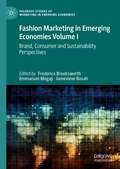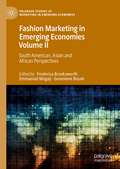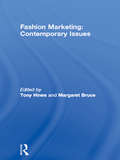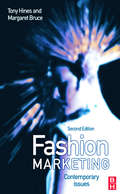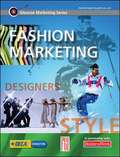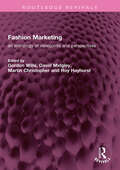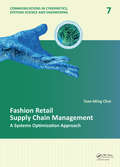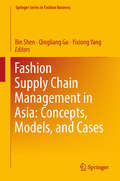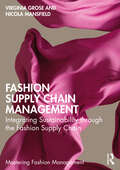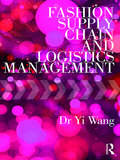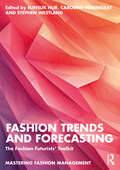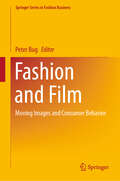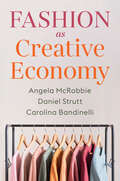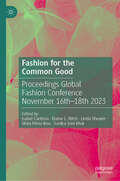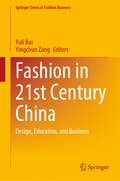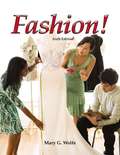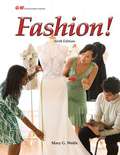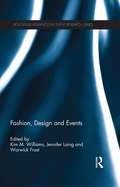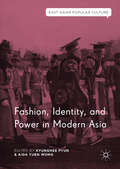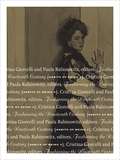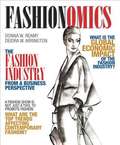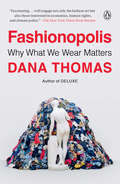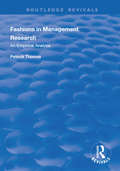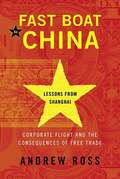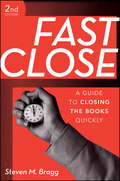- Table View
- List View
Fashion Marketing in Emerging Economies Volume I: Brand, Consumer and Sustainability Perspectives (Palgrave Studies of Marketing in Emerging Economies)
by Emmanuel Mogaji Genevieve Bosah Frederica BrooksworthOver the past few decades emerging markets have experienced an increased share of global manufacturing service within the fashion industry, coupled with an increasing market share, particularly for women’s mid-market apparel. In order for fashion firms to succeed in these markets it is crucial to gain an understanding of the state of the industry, macro-environmental factors, traditions and religious beliefs. A one-size-fits-all approach to global fashion marketing strategy now requires a step-change; fashion firms require dedicated strategies which fit the need of the fashion brands that are operating or seeking to operate within emerging markets. In this contributed volume, authors shed light on fashion marketing strategy for emerging economies and recognise these markets as major growth centres. Chapters explore core topics such as brand management, sustainability, digital marketing, analytics and data science. Covering a wide range of emerging markets, chapters provide case studies from China, India, Ethiopia, Romania, Turkey, Brazil and Nigeria, among others. This book responds to the growing demand for research, information, recommendations and insight from practitioners, entrepreneurs and academics who are eager to understand marketing strategies, tools and technologies that will work within this unique industry.
Fashion Marketing in Emerging Economies Volume II: South American, Asian and African Perspectives (Palgrave Studies of Marketing in Emerging Economies)
by Emmanuel Mogaji Genevieve Bosah Frederica BrooksworthThis book provides and sheds light on insights, challenges, and opportunities to support the development and economic growth of the fashion industries within emerging markets. The fashion industry is growing rapidly in emerging markets; fashion marketers and retailers are increasingly becoming aware of the benefits of this market and are forced to seek their future growth potentials in this part of the world; in addition, marketing strategies, tools and technologies have also evolved. With a growing demand for additional research, information, recommendations and insight from practitioners, entrepreneurs, students, and academics, contributing authors use multiple methods and theories to uncover, analyse, demonstrate, and present the facts in their chapters and provide integrated guideposts for future research. This book is intended to satisfy the needs of stakeholders in the quest for practical insights into fashion marketing in emerging economies, especially in South America, Asia and Africa.It offers timely information on growing areas such as sustainability, digital platforms, supply chain and logistics and provides a good insight for anyone seeking to explore opportunities in emerging market economies. The book offers a much needed resource for students, scholars and practitioners.
Fashion Marketing: Contemporary Issues
by Tony Hines Margaret Bruce'Fashion Marketing' is a book of key chapter contributions from renowned academics and practitioners that addresses many of the contemporary issues facing one of the world's largest and most global of industries. With international contributions from the UK, USA and China, 'Fashion Marketing' covers all of the key themes and issues of this area, including:* forecasting* sourcing* supply chain management (demand management)* new product development* design management* logistics* range planning* colour prediction* market testing * e-commerce* strategyIdeal for use on any undergraduate or postgraduate courses in Fashion, Textiles, Apparel and Retailing Management where there is a need to address the topic of fashion marketing, this book will also serve as a useful, informative and authoritative text for senior managers in the fashion marketing industries wanting to gain further understanding of current and future developments within the industry.
Fashion Marketing: Contemporary Issues
by Tony Hines Margaret BruceA collection of international contributions from renowned academics and practitioners from the US, UK, China, the second edition of Fashion Marketing has been completely updated, revised and expanded to reflect the major changes in the fashion industry since 2001 and covers all of the key themes and issues of the area. Key themes and areas covered include globalization, fast fashion, luxury fashion, offshoring, business-to-business, forecasting, sourcing, supply chain management, new product development, design management, logistics, range planning, color prediction, market testing, e-commerce, and strategy.
Fashion Marketing: Designers Style
by Gigi Ekstrom Margaret JustissGlencoe Marketing Series: Fashion Marketing focuses on fashion marketing, management, and merchandising. Developed to meet state standards and objectives, the Glencoe Marketing Series books have been developed for secondary students taking Marketing II courses. Designed as stand-alone, semester-length texts, books in the Glencoe Marketing Series also function as supplemental texts for Marketing I courses that may use Glencoe Marketing Essentials.
Fashion Marketing: an anthology of viewpoints and perspectives (Routledge Revivals)
by Martin Christopher David Midgley Roy Hayhurst Gordon WillsFirst published in 1973, Fashion Marketing is intended for all whose work is linked to the vagaries of fashion or who are simply fascinated by the subject. Although much of the evidence and material collected here is related to textiles and clothing in particular, businessmen are becoming increasingly aware that fashion now extends its influence beyond its traditional fields. The fickleness of fashion has previously discouraged detailed analysis of trends, and such significant contributions to the literature as have been made often occur in the most unlikely places. It was this inaccessibility which led to the preparation of the present volume, which developed out of the considerable research activity into textile markets by the editors, first at the University of Bradford, and more recently at the Cranfield School of Management to which their research work was transferred in 1972. This book will be of interest to students of business, economics, marketing and fashion.
Fashion Retail Supply Chain Management: A Systems Optimization Approach (Communications in Cybernetics, Systems Science and Engineering)
by Tsan-Ming ChoiFashion Retail Supply Chain Management: A Systems Optimization Approach is a comprehensive reference source that provides the state-of-the-art findings on many important emerging research issues related to retail supply chain management and optimization problems. The book takes an explicit systems approach, and discusses retailled fashion supply ch
Fashion Supply Chain Management in Asia: Concepts, Models, and Cases (Springer Series in Fashion Business)
by Bin Shen Qingliang Gu Yixiong YangThis book serves as a comprehensive guide to understanding the theories and applications in managing the Asian fashion supply chain, presenting both quantitative and exploratory studies. Providing academicians and practitioners insights into the latest developments and models, it also offers diverse perspectives on areas like strategic sourcing, quick response strategies, and other essential parts of the supply chain.
Fashion Supply Chain Management: Integrating Sustainability through the Fashion Supply Chain (Mastering Fashion Management)
by Virginia Grose Nicola MansfieldFashion Supply Chain Management: Integrating Sustainability through the Fashion Supply Chain provides a comprehensive guide to the entire supply chain management process as it relates to the fashion industry; how fashion supply chains work from raw material to finished product, and how generic supply chain concepts are applied in the fashion context. It focuses on contemporary strategic issues with which the sector is currently confronted, some of its current challenges and the innovative ways the sector has developed to respond to these challenges. Concepts such as sustainability, fast fashion, raw materials, logistics and reverse logistics, costing, lean and agile manufacturing and other supply chain strategies are expertly covered in this work, with each area underpinned by the new technologies required to support supply chains in the fashion industry. Each chapter is complemented by an in-depth case study from a relevant global organization so that readers can gain real-world insight, alongside pedagogy to aid student comprehension, including quizzes, end-of-chapter activities, and role play scenarios. This key work is an essential textbook for students studying fashion supply chain, operations, and logistics as part of fashion management undergraduate and postgraduate degrees. Fully comprehensive on theory yet applied to practice, it will equip students with the tools and understanding for a future career in the fashion industry.
Fashion Supply Chain and Logistics Management
by Yi WangThe fashion industry has a dynamic, ever-changing landscape. The last decade has seen a shift in consumer expectations and a heightened dependence on efficient and effective supply chain management. These shifts in the consumer mentality have already forced apparel retailers to adapt, making changes throughout their organisations to maintain consumer loyalty. This new text provides an overview of the latest trends and advances in fashion supply chain management and logistics, including: The fundamentals of fashion supply chain management Strategic management of the fashion supply chain, including the planning aspect of management Technology in fashion supply chain management Radio-frequency identification (RFID) and interoperability Drawing on the expertise of academics, researchers and industry experts, including a wealth of real-life international cases, this book is ideal for advanced undergraduate and postgraduate students and academics of fashion management, logistics and supply chain management, as well as practising professionals.
Fashion Trends and Forecasting: The Fashion Futurists' Toolkit (Mastering Fashion Management)
by Stephen Westland Caroline HemingrayFashion Trends and Forecasting explores how designers, merchandisers, buyers, marketers and strategists use fashion trend forecasting to predict upcoming trends and understand past or current ones.It explains the importance of trend forecasting for businesses and how technology such as artificial intelligence can help to advance it for the future. Addressing both macro- and micro-trends, including fashion styles, textiles and colour trends as well as the impact of technology such as AI and the metaverse, the book offers guidance on how fashion students can address fast-changing consumer needs and demands and identify wider shifts in the cultural, environmental, political and technological worlds. Case studies from globally recognised organisations feature in every chapter, highlighting and contextualising theory for students. Discussion questions, further reading and exercises help facilitate class discussion and deeper understanding.Designed to equip the reader with Fashion Forecasting tools, methods and principles in an accessible and clear way, this text is recommended and core reading for students studying fashion forecasting, fashion buying and fashion marketing.Supplementary online resources can be found at www.routledge.com/9781032541860 and include a short instructor’s manual of points to be used for seminar discussions and chapter-by-chapter PowerPoint slides for instructors.
Fashion and Film: Moving Images and Consumer Behavior (Springer Series in Fashion Business)
by Peter BugThis book aims to explore various aspects of the use of moving images in fashion retail and fashion apparel companies in-store or online. The use of moving images is growing in numbers and in relevance for consumers. Films can be used in various forms by fashion businesses in traditional media like cinema or TV and in modern forms like in social media or moving images in high street stores.The book provides a data-oriented analysis of the state-of-the-art with certain future outlooks. Additional areas of covering fashion in moving images, such as ‘fashion company identity films’ or ‘fashion and music videos’ are covered in order to get a more complete analysis from a consumer influenced perspective.
Fashion as Creative Economy: Micro-Enterprises in London, Berlin and Milan
by Angela McRobbie Daniel Strutt Carolina BandinelliFashion is under the spotlight like never before. Activists call for environmental accountability, and wide-ranging debates highlight exploitation across global supply chains and the reliance on unpaid labour. Digital technology undermines traditional fashion companies, while small-scale independent fashion designers provide radical innovations in design and work in more socially inclusive ways. This book contributes to a new sociology of fashion. Focusing on the working lives of independent designers and based on ethnographic research and interviews carried out in London, Berlin and Milan, the authors consider the urban policy regimes in place in these cities. They analyse how these regimes shape the microenterprises and the emerging political economy, as well as the structures needed for designers to flourish. They also develop several key concepts – the ‘milieu of fashion labour’, ‘social fashion’ and ‘fashion diversity’ – and chart the new world of digital fashion-tech and e-commerce. Drawing on lessons from European initiatives and recognizing the capacity of microenterprises and start-ups to determine fashion’s future, the authors call for the industry to be significantly decentralized to ensure more diversity and less exclusivity.
Fashion for the Common Good: Proceedings Global Fashion Conference November 16th - 18th 2023
by Isabel Cantista Elaine L. Ritch Linda Shearer Silvia Pérez-Bou Sonika Soni KharThis book presents state-of-the-art research from around the world on how the fashion industry can help in the transition towards a sustainable model of development and a circular economy. It presents the proceedings of the 10th Global Fashion Conference held in 2023, which since its creation in 2008, has endeavoured to contribute to the recognition of a sectoral innovation system, which may lead to regional and transnational policies that promote innovation for the sake of sustainability. Presenting cutting edge research on how fashion contributes to the common good, the book covers core topics including the circular economy, social innovation, fashion law and sustainability, sustainable finance, and education for sustainability, offering a meaningful contribution to the UN Sustainable Development Goals.
Fashion in 21st Century China: Design, Education, and Business (Springer Series in Fashion Business)
by Yuli Bai Yingchun ZangThis book explores the dynamic landscape of fashion in China since the beginning of the 21st century through an integrated perspective. The book considers key questions related to the changes in China’s fashion dynamics driven largely by the shifts in the mindset of Chinese consumers due to the current sociocultural contexts. To provide an understanding of these important shifts, this three-part monograph pays close attention to the new generation of Chinese fashion designers and consumers. The book explores in detail related topics such as, how today’s Chinese consumers relate to foreign brands, the meaning of apparel brands as identity symbols or cultural signs to contemporary young consumers, the attractiveness of Western fashion designers and brands in the eyes of current Chinese consumers as compared to past consumers, and how brands could adapt to the online-centered consumption behavior. The book serves as an insightful update on the Chinese fashion landscape for researchers, practitioners and passionate followers of its evolution.
Fashion!
by Mary C. WolfeDesigned for non-laboratory textile and clothing courses, this text covers all aspects of the fashion scene.
Fashion!
by Mary G. WolfeFashion! gives your students an in-depth look at the exciting world of the fashion scene. This colorful text is designed for nonlaboratory textile and clothing courses. Fashion! includes hundreds of images to illustrate concepts and enhance learning. Fashion! can help your students become future employees in fashion-related businesses by helping them: * Understand the apparel industry and learn the skills needed to become more attuned to consumer concerns. * Explore globalization and trends for textile companies, apparel manufacturers, retailers, and consumers, including industry-wide collaboration, multichannel retailing, and cross-channel shopping. * Analyze how Internet technology is changing fashion firms' product development, promotion, and selling through electronics (e-commerce) and how mobile applications and social media affect consumer comparison shopping and buying practices (m-commerce). * Weigh the dilemma of imports, environmental sustainability, and ethical and social issues about companies when buying their goods. * Discuss how to deter, detect, and defend against identity theft. * Describe fashion design techniques. * Gain exposure to the career clusters and the many career opportunities in the apparel industry.
Fashion, Design and Events (Routledge Advances in Event Research Series)
by Warwick Frost Jennifer Laing Kim M. WilliamsThe importance of fashion and design in an events context remains under-researched, despite their ubiquity and significance from a societal and economic perspective. Fashion-themed events, for example, appeal to broad audiences and may tour the globe. Staging these events might help to brand destinations, boost visitor numbers and trigger popular debates about the contributions that fashion and design can make to identity. They may also tell us something about our culture and wider society. This edited volume for the first time examines fashion and design events from a social perspective, including the meanings they bestow and their potential economic, cultural and personal impacts. It explores the reasons for their popularity and influence, and provides a critique of their growth in different markets. Events examined include fashion weeks, fashion or design themed exhibitions, historical re-enactments, extreme/alternative fashion and design events, and large-scale public events such as royal weddings and horse races. International examples and case studies are drawn from countries as diverse as the USA, UK, Germany, Bhutan, New Zealand and Australia. These are used to develop and critique various thematic concepts linked to fashion and design events, such as identity, gender, aspirations and self-image, commodification, authenticity, destination development and marketing, business strategy and protection/infringement of intellectual property. Fashion, Design and Events also provides a futurist view of these types of events and sets out a future research agenda.This book has a unique focus on events associated with fashion and design and features a swathe of disciplinary backgrounds. It will appeal to a broad academic audience, such as students of art and design, cultural studies, tourism, events studies, sociology and marketing.
Fashion, Identity, and Power in Modern Asia (East Asian Popular Culture)
by Kyunghee Pyun Aida Yuen WongThis edited volume on radical dress reforms in East Asia takes a fresh look at the symbols and languages of modernity in dress and body. Dress reform movements around the turn of the twentieth century in the region have received little critical attention as a multicultural discourse of labor, body, gender identity, colonialism, and government authority. With contributions by leading experts of costume/textile history of China, Korea, and Japan, this book presents up-to-date scholarship using diverse methodologies in costume history, history of consumption, and international trade. Thematically organized into sections exploring the garments and uniforms, accessories, fabrics, and fashion styles of Asia, this edited volume offers case studies for students and scholars in an ever-expanding field of material culture including, but not limited to, economic history, visual culture, art history, history of journalism, and popular culture. Fashion, Identity, and Power in Modern Asia stimulates further research on the impact of modernity and imperialism in neglected areas such as military uniform, school uniform, women’s accessories, hairstyles, and textile trade.
Fashioning the Nineteenth Century: Habits of Being 3
by Cristina GiorcelliIn nineteenth-century Europe and the United States, fashion—once the province of the well-to-do—began to make its way across class lines. At once a democratizing influence and a means of maintaining distinctions, gaps in time remained between what the upper classes wore and what the lower classes later copied. And toward the end of the century, style also moved from the streets to the parlor. The third in a four-part series charting the social, cultural, and political expression of clothing, dress, and accessories, Fashioning the Nineteenth Century focuses on this transformative period in an effort to show how certain items of apparel acquired the status of fashion and how fashion shifted from the realm of the elites into the emerging middle and working classes—and back.The contributors to this volume are leading scholars from France, Italy, and the United States, as well as a practicing psychoanalyst and artists working in fashion and with textiles. Whether considering girls&’ school uniforms in provincial Italy, widows&’ mourning caps in Victorian novels, Charlie&’s varying dress in Kate Chopin&’s eponymous story, or the language of clothing in Henry James, the essays reveal how changes in ideals of the body and its adornment, in classes and nations, created what we now understand to be the imperatives of fashion.Contributors: Dagni Bredesen, Eastern Illinois U; Carmela Covato, U of Rome Three; Agnès Derail-Imbert, École Normale Supérieure/VALE U of Paris, Sorbonne; Clair Hughes, International Christian University of Tokyo; Bianca Iaccarino Idelson; Beryl Korot; Anna Masotti; Bruno Monfort, Université of Paris, Ouest Nanterre La Défense; Giuseppe Nori, U of Macerata, Italy; Marta Savini, U of Rome Three; Anna Scacchi, U of Padua; Carroll Smith-Rosenberg, U of Michigan.
Fashionomics
by Donna W. Reamy Deidra W. ArringtonFashionomics gives students a fundamental understanding of economic principles and their direct application to the rational and decision-making of the fashion industry. From the Industrial Revolution to contemporary trends in textiles and fashion, this text explores business and economic theories through real-world, up-to-date examples applied to the fashion industry.
Fashionopolis: The Price of Fast Fashion and the Future of Clothes
by Dana ThomasAn investigation into the damage wrought by the colossal clothing industry and the grassroots, high-tech, international movement fighting to reform it <P><P>What should I wear? It’s one of the fundamental questions we ask ourselves every day. More than ever, we are told it should be something new. Today, the clothing industry churns out 80 billion garments a year and employs every sixth person on Earth. Historically, the apparel trade has exploited labor, the environment, and intellectual property—and in the last three decades, with the simultaneous unfurling of fast fashion, globalization, and the tech revolution, those abuses have multiplied exponentially, primarily out of view. We are in dire need of an entirely new human-scale model. <P><P>Bestselling journalist Dana Thomas has traveled the globe to discover the visionary designers and companies who are propelling the industry toward that more positive future by reclaiming traditional craft and launching cutting-edge sustainable technologies to produce better fashion. <P><P>In Fashionopolis, Thomas sees renewal in a host of developments, including printing 3-D clothes, clean denim processing, smart manufacturing, hyperlocalism, fabric recycling—even lab-grown materials. From small-town makers and Silicon Valley whizzes to such household names as Stella McCartney, Levi’s, and Rent the Runway, Thomas highlights the companies big and small that are leading the crusade. <P><P>We all have been casual about our clothes. It's time to get dressed with intention. Fashionopolis is the first comprehensive look at how to start.
Fashions in Management Research: An Empirical Analysis (Routledge Revivals)
by Patrick ThomasPublished in 1999, this text sets out to analyze fashions in management literature through studying patterns in the citations offered to leading management authors. Particular attention is paid to those publications which are cited extensively, but only for a short period - these publications are regarded as potentially subject to fashionable pressures. More detailed case studies of fashionable publications are undertaken to gain a greater understanding of what factors may lead to management fashions. The book represents a large-scale empirical analysis of management fashions and culminates in an empirically validated theory of management fashions.
Fast Boat to China
by Andrew RossMost Americans today are aware that jobs are being outsourced to China, India, and other nations at an alarming rate. From factory jobs to white-collar, high-tech positions, the exporting of labor is one of the most controversial issues in America. Yet few people know much about the other end — about the people who are actually working these jobs and how their own lives have been throw into tumult by these new economic forces. Andrew Ross spent a year in China, interviewing local employees and their ...
Fast Close
by Steven M. BraggPraise for Fast Close: A Guide to Closing the Books Quickly"Steve captures the essence of the problems affecting the financial close process within corporations of all sizes; from the period close of subledgers and general ledger through financial reporting, and the relationship and interdependencies of governance, people and technology. A must-read for the corporate controller."--David Taylor, ACMA, MBA, VP Strategy, Trintech Inc."Fast Close: A Guide to Closing the Books Quickly, Second Edition is a must-read for today's busy controllers. Steven Bragg points out everything that can be done outside the close that you just never realized didn't actually have to be part of the month-end close process! Very commonsensical approach!"--Kathleen Schneibel, mba, cpa, Controller/CFO for Hire, KMAS Consulting LLC"A well-executed 'fast close' can bring many valuable benefits to any company, from improving organizational performance to transforming accounting executives from financial historians to trusted advisors. In Fast Close, Second Edition, Steve systematically breaks down the steps required to achieve a fast close in both public and private companies, providing financial executives with tips, checklists, and a cost-effective road map to implement fast close procedures in virtually any company."--Matthew Posta, Esq., CPA, Vice President of Finance, Key Air, LLCFROM THE FIRST EDITION"This is an outstanding book in which Steve reveals his secrets to a fast close. Having personally experienced his (one-day) fast close for years and enjoyed the beneficial impact on my company, I highly recommend this book for all financial officers who desire to have a large, favorable impact on their company."--Richard V. Souders, President and CEO, Kaba Workforce Solutions
